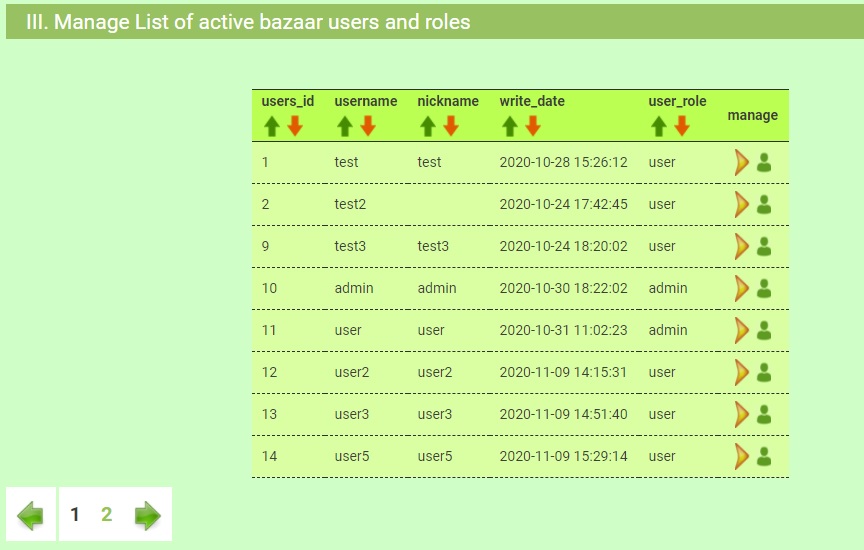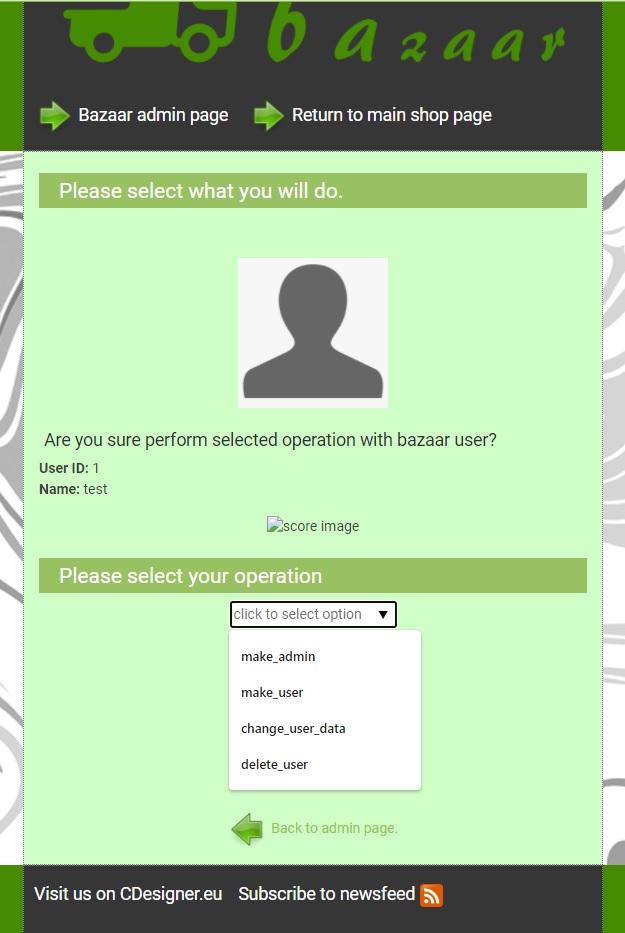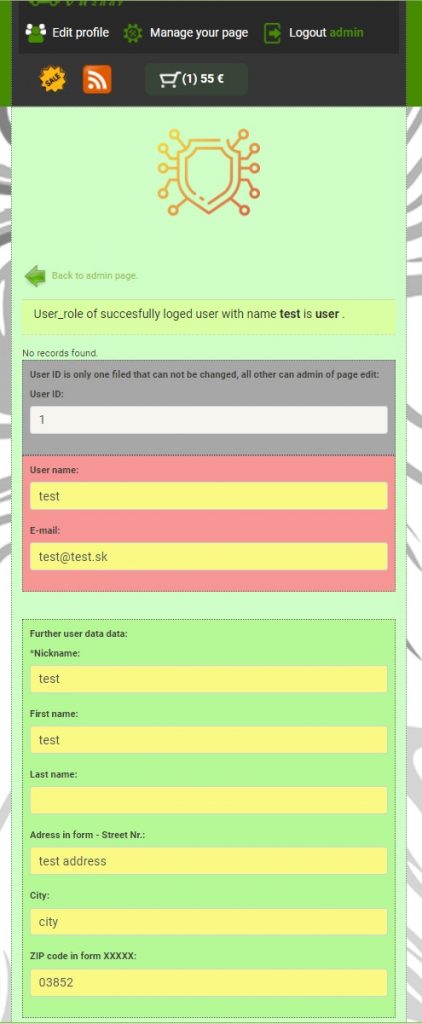Administrator of the page must be able display info about user, change their role or delete them. User password is sensitive information and can not be save as plain text. Our database store only secure hashes of them.
Basic functionality for management of the user can be described this way. Page admin on their own admin page has user administration section with list of all users. These information are displayed in a table. At the end of appropriate row is link pointing to second context page with option for change category of the user, edit of user data or enable to remove a user.
Only editing of user data lead to another page very similiar to the users profile page, where through the form can be data reedit.
Whole process depict following sequence of screenshots.
Our solution consist from part generating user list in form a table in admin.php script:
/***********************************************************************/
/* III. Showing registered user table with option for adminster them */
/***********************************************************************/
$results_per_page_3 = 8;
//calculate pagination information
$cur_page = isset($_GET[‚page‘]) ? $_GET[‚page‘] : 1;
// results per page default declater as 5 on top of page and changed in submitt part after reset button handling $results_per_page = 5;
$skip = (($cur_page -1) * $results_per_page_3);
// first question to database table for obtaining number of published items in a database – obtain value for $total
$sql =“SELECT * FROM bazaar_user“; // read in reverse order of score – highest score first
$output_for_number_rows_count_3 = mysqli_query($dbc, $sql); // query database
$total_3 = mysqli_num_rows($output_for_number_rows_count_3); //get number of rows in databse
// querying bazaar_category for listed category items
//older approach without SORT functionality
// $sql = „SELECT * FROM bazaar_item ORDER BY item_add_date DESC LIMIT $skip, $results_per_page“; // read in reverse order of score – highest score first
/**
* SORTING – PART II. Here is into sql request implemented along which filed and how ascend or desc is output ordered
*/
if(isset($_GET[‚sort_by‘]) && isset($_GET[‚order‘]) ){
// take a data from GET link generated by adminscript
$sort_by = htmlspecialchars($_GET[‚sort_by‘]);
$order = htmlspecialchars($_GET[‚order‘]);
// debug echo „sort_by“.$sort_by;
// debug echo „order“.$order;
if(($sort_by == „users_id“) && ($order == „1“)) { // along name and ASC order
$sql = „SELECT * FROM bazaar_user ORDER BY users_id ASC LIMIT $skip, $results_per_page_3“;
};
if(($sort_by == „users_id“) && ($order == „-1“)) { // along name and DESC order
$sql = „SELECT * FROM bazaar_user ORDER BY users_id DESC LIMIT $skip, $results_per_page_3“;
};
if(($sort_by == „username“) && ($order == „1“)) { // along name and ASC order
$sql = „SELECT * FROM bazaar_user ORDER BY username ASC LIMIT $skip, $results_per_page_3“;
};
if(($sort_by == „username“) && ($order == „-1“)) { // along name and DESC order
$sql = „SELECT * FROM bazaar_user ORDER BY username DESC LIMIT $skip, $results_per_page_3“;
};
if(($sort_by == „nickname“) && ($order == „1“)) { // along name and ASC order
$sql = „SELECT * FROM bazaar_user ORDER BY nickname ASC LIMIT $skip, $results_per_page_3“;
};
if(($sort_by == „nickname“) && ($order == „-1“)) { // along name and DESC order
$sql = „SELECT * FROM bazaar_user ORDER BY nickname DESC LIMIT $skip, $results_per_page_3“;
};
if(($sort_by == „write_date“) && ($order == „1“)) { // along name and ASC order
$sql = „SELECT * FROM bazaar_user ORDER BY write_date ASC LIMIT $skip, $results_per_page_3“;
};
if(($sort_by == „write_date“) && ($order == „-1“)) { // along name and DESC order
$sql = „SELECT * FROM bazaar_user ORDER BY write_date DESC LIMIT $skip, $results_per_page_3“;
};
if(($sort_by == „user_role“) && ($order == „1“)) { // along price and ASC order
$sql = „SELECT * FROM bazaar_user ORDER BY user_role ASC LIMIT $skip, $results_per_page_3“;
};
if(($sort_by == „user_role“) && ($order == „-1“)) { // along price and DESC order
$sql = „SELECT * FROM bazaar_user ORDER BY user_role DESC LIMIT $skip, $results_per_page_3“;
};
if(($sort_by == „default“)) { // along category and DESC order
$sql = „SELECT * FROM bazaar_user ORDER BY users_id ASC LIMIT $skip, $results_per_page_3“;
};
} else { // first run without ordering – no get link generated
$sql = „SELECT * FROM bazaar_user ORDER BY users_id ASC LIMIT $skip, $results_per_page_3“; // read in reverse order of score – highest score first
}
// processing table output form bazaar_category
echo „<h4>III. Manage List of active bazaar users and roles</h4>“;
//echo „<br>“;
//echo ‚ <button class=“btn btn-secondary btn-lg “ onclick=“location.href=\’managecategory.php\'“ type=“button“> Create new category-subcategory -> </button>‘;
echo „<br>“; echo „<br>“;
if($output = mysqli_query($dbc, $sql)){
if(mysqli_num_rows($output) > 0){ // if any record obtained from SELECT query
// create table output
echo „<table>“; //head of table
echo „<tr>“;
echo ‚<th>users_id <br /><a id=“SORT“ href=“admin.php?sort_by=users_id&order=1″> <img id=“arrow“ src=“./images/arrowup.png“> </a>
<a id=“SORT“ href=“admin.php?sort_by=users_id&order=-1″> <img id=“arrow“ src=“./images/arrowdown.png“> </a></th>‘;
echo ‚<th>username <br /><a id=“SORT“ href=“admin.php?sort_by=username&order=1″> <img id=“arrow“ src=“./images/arrowup.png“> </a>
<a id=“SORT“ href=“admin.php?sort_by=username&order=-1″> <img id=“arrow“ src=“./images/arrowdown.png“> </a></th>‘;
echo ‚<th>nickname <br /><a id=“SORT“ href=“admin.php?sort_by=nickname&order=1″> <img id=“arrow“ src=“./images/arrowup.png“> </a>
<a id=“SORT“ href=“admin.php?sort_by=nickname&order=-1″> <img id=“arrow“ src=“./images/arrowdown.png“> </a></th>‘;
echo ‚<th>write_date <br /><a id=“SORT“ href=“admin.php?sort_by=write_date&order=1″> <img id=“arrow“ src=“./images/arrowup.png“> </a>
<a id=“SORT“ href=“admin.php?sort_by=write_date&order=-1″> <img id=“arrow“ src=“./images/arrowdown.png“> </a></th>‘;
echo ‚<th>user_role <br /><a id=“SORT“ href=“admin.php?sort_by=user_role&order=1″> <img id=“arrow“ src=“./images/arrowup.png“> </a>
<a id=“SORT“ href=“admin.php?sort_by=user_role&order=-1″> <img id=“arrow“ src=“./images/arrowdown.png“> </a></th>‘;
echo „<th>manage</th>“;
echo „</tr>“;
while($row = mysqli_fetch_array($output)){ //next rows outputed in while loop
echo “ <div class=\“mailinglist\“> “ ;
echo „<tr>“;
echo „<td>“ . $row[‚users_id‘] . „</td>“;
echo „<td>“ . $row[‚username‘] . „</td>“;
echo „<td>“ . $row[‚nickname‘] . „</td>“;
echo „<td>“ . $row[‚write_date‘] . „</td>“;
echo „<td>“ . $row[‚user_role‘] . „</td>“;
// removal line with removing link line
// echo „<td colspan=\“1\“> Manage entry: </td>“; // description on first line
echo ‚<td colspan=“1″><a id=“DEL“ href=“manageuser.php?users_id=‘.$row[‚users_id‘] . ‚&username=‘
. $row[‚username‘] . ‚&user_role=‘. $row[‚user_role‘] .'“><center><img id=“next“ src=“./images/manageuser.png“></center></a></td></tr>‘; //construction of GETable link
// for removecategory.php input
echo „</tr>“;
echo “ </div> “ ;
}
echo „</table>“;
//count nuber of pages total
$num_pages_3 = ceil($total_3 / $results_per_page_3);
//generate navigational page links if we have more than one page
if($num_pages_3 > 1) {
$user_search = „“; // not implemented yet, then set as clear values
if(empty($sort_by)) { // if not obtained by get then default order is applied
$sort_by=“default“;
};
if(empty($order)) { // if not obtained by get then default order is applied
$order=“1″;
};
// included function for pagination generation function stored in functions.php page
echo generate_page_links($user_search, $sort_by, $order, $cur_page, $num_pages_3);
echo „<br><br>“;
}
echo „<br />“;
// Free result set
mysqli_free_result($output);
} else{
echo „There is no benchmark result in chart. Please wirite one.“; // if no records in table
}
} else{
echo „ERROR: Could not able to execute $sql. “ . mysqli_error($dbc); // if database query problem
}
// Close connection
mysqli_close($dbc);
?>
Example now contains ordering functionality, this part will be explained with details in later published articles.
All functionality for specific user management is located in script manageuser.php. This script is invoked through GET link from admin.php page.
Script obtain data from GET link after invocation, but second submitting mechanism with post enable selection from other specific operation.
Changing role from user to admin and vice versa, deletion of user are created with appropriate SQL statment executed at SQL database.
After submitting request for change_user_data, javscript redirect currently logged admin on manageuserdata.php and generate GET link with ID and Username.
Content of manageuserdata.php or whole script of project can be obtaned from github here.
Previous text show example of way how to add user management functionality to our bazaarap. This approach demonstrate classical way for user management. Real world application need further security hardening with eliminating GET data exchange. POST method with SESSION verification provide further level of validation.





